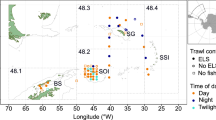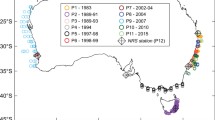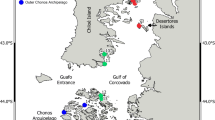Abstract
The study of meroplankton communities in the coastal Ross Sea has been difficult due to the logistical challenges associated with sampling in remote areas and with the hurdle of larval identification. As a result, it has not been possible to estimate the latitudinal changes in reproductive strategies of marine invertebrates and to investigate Thorson’s rule—that planktotrophy is less favoured than lecithotrophy and brooding at high latitudes—along the southernmost coastline on Earth. As part of the Latitudinal Gradient Project (Antarctica New Zealand), we studied the meroplankton communities at three sites on the Victoria Land Coast and identified—using morphological and genetic information—11,117 larvae from 52 molecular Operational Taxonomical Units. This allowed for the analysis of patterns in larval diversity and abundance with latitude. Genetic identification permitted the usage of multivariate techniques to study changes in the meroplankton community and to further investigate the latitudinal variation in larval mode of nutrition. Our results showed distinct larval communities at each site, with species dominating nearby benthos being crucial in site discrimination, but with no latitudinal gradients in abundance or diversity. Planktotrophy was predominant in all three sites reflecting the minimal effect of Thorson’s rule within the Ross Sea.







Similar content being viewed by others
References
Absher, T. M., G. Boehs, A. R. Feijó & A. C. Da Cruz, 2003. Pelagic larvae of benthic gastropods from shallow Antarctic waters of Admiralty Bay, King George Island. Polar Biology 26(6): 359–364.
Ameneiro, J., B. Mouriño-Carballido, J. Parapar & E. Vázquez, 2012. Abundance and distribution of invertebrate larvae in the Bellingshausen Sea (West Antarctica). Polar Biology 35(9): 1–15.
Anderson, M. J., 2005. PERMANOVA: a FORTRAN computer program for permutational multivariate analysis of variance Permutational multivariate analysis of variance, a computer program. Department of Statistics, University of Auckland, New Zealand: 24.
Arrigo, K. R. & G. L. van Dijken, 2003. Phytoplankton dynamics within 37 Antarctic coastal polynya systems. Journal of Geophysical Research: Oceans 108(C8): 3271.
Berkman, P. A., R. Cattaneo-Vietti, M. Chiantore, C. Howard-Williams, V. Cummings & R. Kvitek, 2005. Marine research in the Latitudinal Gradient Project along Victoria Land, Antarctica. Scientia Marina 69(Suppl. 2): 57–63.
Bhaud, M., P. Koubbi, S. Razouls, O. Tachon & A. Accornero, 1999. Description of planktonic polychaete larvae from Terre Adelie and the Ross Sea (Antarctica). Polar Biology 22(5): 329–340.
Brethes, J. C., G. Ferreyra & S. Delavega, 1994. Distribution, growth and reproduction of the limpet Nacella (Patinigera) concinna (Strebel 1908) in relation to potential food availability, in Esperanza Bay (Antarctic Peninsula). Polar Biology 14(3): 161–170.
Brockington, S., L. S. Peck & P. A. Tyler, 2007. Gametogenesis and gonad mass cycles in the common circumpolar Antarctic echinoid Sterechinus neumayeri. Marine Ecology Progress Series 330: 139–147.
Clarke, A., 2008. Antarctic marine benthic diversity: patterns and processes. Journal of Experimental Marine Biology and Ecology 366(1–2): 48–55.
Cummings, V. J., S. Thrush, A. Norkko, N. Andrew, J. Hewitt, G. Funnell & A. M. Schwarz, 2006. Accounting for local scale variability in benthos: implications for future assessments of latitudinal trends in the coastal Ross Sea. Antarctic Science 18(4): 633–644.
Cummings, V. J., S. F. Thrush, M. Chiantore, J. E. Hewitt & R. Cattaneo-Vietti, 2010. Macrobenthic communities of the north-western Ross Sea shelf: links to depth, sediment characteristics and latitude. Antarctic Science 22(6): 793–804.
Dayton, P. K., W. A. Newman & J. Oliver, 1982. The vertical zonation of the deep-sea Antarctic acorn barnacle, Bathylasma corolliforme (Hoek): experimental transplants from the shelf into shallow water. Journal of Biogeography 9(2): 95–109.
De Domenico, F., M. Chiantore, S. Buongiovanni, M. P. Ferranti, S. Ghione, S. Thrush, V. Cummings, J. Hewitt, K. Kroeger & R. Cattaneo-Vietti, 2006. Latitude versus local effects on echinoderm assemblages along the Victoria Land coast, Ross Sea. Antarctica. Antarctic Science 18(4): 655–662.
Drummond, A. J., B. Ashton, S. Buxton, M. Cheung, A. Cooper, C. Duran, M. Field, J. Heled, M. Kearse, S. Markowitz, R. Moir, S. Stones-Havas, S. Sturrock, T. Thierer & A. Wilson, 2011. Geneious v6.1. Available from http://www.geneious.com/.
Gallego, R., S. Lavery & M. A. Sewell, 2014. The meroplankton community of the oceanic Ross Sea during late summer. Antarctic Science 26(4): 345–360.
Grange, L. J., P. A. Tyler, L. S. Peck & N. Cornelius, 2004. Long-term interannual cycles of the gametogenic ecology of the Antarctic brittle star Ophionotus victoriae. Marine Ecology Progress Series 278: 141–155.
Grange, L. J., L. S. Peck & P. A. Tyler, 2011. Reproductive ecology of the circumpolar Antarctic nemertean Parborlasia corrugatus: no evidence for inter-annual variation. Journal of Experimental Marine Biology and Ecology 404(1–2): 98–107.
Grant, R. A. & K. Linse, 2009. Barcoding Antarctic biodiversity: current status and the CAML initiative, a case study of Marine invertebrates. Polar Biology 32(11): 1629–1637.
Heimeier, D., S. Lavery & M. A. Sewell, 2010a. Molecular species identification of Astrotoma agassizii from planktonic embryos: further evidence for a cryptic species complex. Journal of Heredity 101(6): 775–779.
Heimeier, D., S. Lavery & M. A. Sewell, 2010b. Using DNA barcoding and phylogenetics to identify Antarctic invertebrate larvae: lessons from a large scale study. Marine Genomics 3(3–4): 165–177.
Hoffman, J. I., L. S. Peck, K. Linse & A. Clarke, 2011. Strong population genetic structure in a broadcast-spawning antarctic marine invertebrate. Journal of Heredity 102(1): 55–66.
Howard-Williams, C., D. Peterson, W. B. Lyons, R. Cattaneo-Vietti & S. Gordon, 2006. Measuring ecosystem response in a rapidly changing environment: the Latitudinal Gradient Project. Antarctic Science 18(4): 465–471.
Howard-Williams, C., I. Hawes & S. Gordon, 2010. The environmental basis of ecosystem variability in Antarctica: research in the Latitudinal Gradient Project. Antarctic Science 22 (Special Issue 06): 591–602.
Hunter, R. L. & K. M. Halanych, 2008. Evaluating connectivity in the brooding brittle star Astrotoma agassizii across the Drake Passage in the Southern Ocean. Journal of Heredity 99(2): 137–148.
Kang, D. H., I. Y. Ahn & K. S. Choi, 2009. The annual reproductive pattern of the Antarctic clam, Laternulla eliptica from Marian Cove. King George Island. Polar Biology 32(4): 517–528.
Laptikhovsky, V., 2006. Latitudinal and bathymetric trends in egg size variation: a new look at Thorson’s and Rass’s rules. Marine Ecology 27(1): 7–14.
Levin, L. A. & T. S. Bridges, 2001. Pattern and diversity in the reproduction and development. In McEdward, L. R. (ed.), Ecology of Marine Invertebrate Larvae. CRC Press, London: 2–48.
Marshall, D. J., P. J. Krug, E. K. Kupriyanova, M. Byrne & R. B. Emlet, 2012. The biogeography of marine invertebrate life histories. Annual Review of Ecology, Evolution, and Systematics 43(1): 97–114.
Martin, S., R. S. Drucker & R. Kwok, 2007. The areas and ice production of the western and central Ross Sea polynyas, 1992-2002, and their relation to the B-15 and C-19 iceberg events of 2000 and 2002. Journal of Marine Systems 68(1–2): 201–214.
Mercier, A., M. A. Sewell & J.-F. Hamel, 2013. Pelagic propagule duration and developmental mode: reassessment of a fading link. Global Ecology and Biogeography 22(5): 517–530.
Mileikovsky, S. A., 1971. Types of larval development in marine bottom invertebrates, their distribution and ecological significance: a re-evaluation. Marine Biology 10(3): 193–213.
Murray, J., 1895. General observations on the distribution of marine organisms. Report scientific research, voyage of the HMS challenger, a summary of the scientific results, second part: 1431–1462.
Olson, R. R., J. A. Runstadler & T. D. Kocher, 1991. Whose larvae? Nature 351(6325): 357–358.
Pearse, J. S., J. B. McClintock & I. Bosch, 1991. Reproduction of Antarctic benthic marine invertebrates: tempos, modes, and timing. American Zoologist 31(1): 65–80.
Poulin, É., A. T. Palma & J. P. Féral, 2002. Evolutionary versus ecological success in Antarctic benthic invertebrates. Trends in Ecology and Evolution 17(5): 218–222.
Povero, P., M. Castellano, N. Ruggieri, L. S. Monticelli, V. Saggiomo, M. Chiantore, M. Guidetti & R. Cattaneo-Vietti, 2006. Water column features and their relationship with sediments and benthic communities along the Victoria Land coast, Ross Sea, summer 2004. Antarctic Science 18(4): 603–613.
Pruszak, Z., 1980. Currents circulation in the waters of Admiralty Bay (region of Arctowski Station on King George Island). Polish Polar Research 1(1): 55–74.
Rehm, P., S. Thatje, W. E. Arntz, A. Brandt & O. Heilmayer, 2006. Distribution and composition of macrozoobenthic communities along a Victoria-Land transect (Ross Sea, Antarctica). Polar Biology 29(9): 782–790.
Rehm, P., R. A. Hooke & S. Thatje, 2011. Macrofaunal communities on the continental shelf off Victoria Land, Ross Sea. Antarctica. Antarctic Science 23(05): 449–455.
Ryan, K. G., E. N. Hegseth, A. Martin, S. K. Davy, R. O’Toole, P. J. Ralph, A. McMinn & C. J. Thorn, 2006. Comparison of the microalgal community within fast ice at two sites along the Ross Sea coast. Antarctica. Antarctic Science 18(4): 583–594.
Schiaparelli, S., A. N. Lörz & R. Cattaneo-Vietti, 2006. Diversity and distribution of mollusc assemblages on the Victoria Land coast and the Balleny Islands, Ross Sea. Antarctica. Antarctic Science 18(4): 615–631.
Schiaparelli, S., C. Ghiglione, M. Alvaro, H. Griffiths & K. Linse, 2014. Diversity, abundance and composition in macrofaunal molluscs from the Ross Sea (Antarctica): results of fine-mesh sampling along a latitudinal gradient. Polar Biology 37(6): 859–877.
Sewell, M. A., 2005. Examination of the meroplankton community in the south-western Ross Sea, Antarctica, using a collapsible plankton net. Polar Biology 28(2): 119–131.
Sewell, M. A., 2006. The meroplankton community of the northern Ross Sea: a preliminary comparison with the McMurdo Sound region. Antarctic Science 18(4): 595–602.
Sewell, M. A. & J. A. Jury, 2011. Seasonal patterns in diversity and abundance of the high antarctic meroplankton: plankton sampling using a Ross Sea desalination plant. Limnology and Oceanography 56(5): 1667–1681.
Sewell, M. A., S. Lavery & C. S. Baker, 2006. Whose larva is that? Molecular identification of planktonic larvae of the Ross Sea. New Zealand Aquatic Environment and Biodiversity Report No. 3: 57.
Shannon, C. E., 1948. A mathematical theory of communication. Bell System Technical Journal 27: 379–423.
Smith, D. L. & K. B. Johnson, 1977. A guide to marine coastal plankton and marine invertebrate larvae. Kendall/Hunt Publishing Company. Dubuque, Iowa.
Smith Jr., W. O., D. G. Ainley & R. Cattaneo-Vietti, 2007. Trophic interactions within the Ross Sea continental shelf ecosystem. Philosophical Transactions of the Royal Society B: Biological Sciences 362(1477): 95–111.
Smith Jr., W. O., D. G. Ainley, K. R. Arrigo & M. S. Dinniman, 2014. The oceanography and ecology of the Ross Sea. Annual Review of Marine Science 6: 469–487.
Stanwell-Smith, D. & A. Clarke, 1998. Seasonality of reproduction in the cushion star Odontaster validus at Signy Island. Antarctica. Marine Biology 131(3): 479–487.
Stanwell-Smith, D., A. Hood & L. S. Peck, 1997. A field guide to the pelagic invertebrate larvae of the maritime Antarctic. British Antarctic Survey, Cambridge.
Steedman, F. H., 1976. Zooplankton fixation and preservation, Vol. 4. UNESCO, Paris.
Thomson, C. W., 1876. Notice of some peculiarities in the mode of propagation of certain echinoderms of the Southern Sea. Journal of the Linnean Society of London, Zoology 13(66): 55–79.
Thorson, G., 1950. Reproductive and larval ecology of marine bottom invertebrates. Biological Reviews 25(1): 1–45.
Thrush, S., P. Dayton, R. Cattaneo-Vietti, M. Chiantore, V. Cummings, N. Andrew, I. Hawes, S. Kim, R. Kvitek & A.-M. Schwarz, 2006. Broad-scale factors influencing the biodiversity of coastal benthic communities of the Ross Sea. Deep Sea Research Part II: Topical Studies in Oceanography 53(8): 959–971.
Todd, C. D., M. S. Laverack & G. A. Boxshall, 1996. Coastal Marine Zooplankton, 2nd ed. Cambridge University Press, Cambridge.
Tyler, P. A., S. Reeves, L. Peck, A. Clarke & D. Powell, 2003. Seasonal variation in the gametogenic ecology of the Antarctic scallop Adamussium colbecki. Polar Biology 26(11): 727–733.
Vacchi, M., M. La Mesa, M. Dalu & J. Macdonald, 2004. Early life stages in the life cycle of Antarctic silverfish, Pleuragramma antarcticum in Terra Nova Bay, Ross Sea. Antarctic Science 16(03): 299–305.
Vacchi, M., A. L. DeVries, C. W. Evans, M. Bottaro, L. Ghigliotti, L. Cutroneo & E. Pisano, 2012. A nursery area for the Antarctic silverfish Pleuragramma antarcticum at Terra Nova Bay (Ross Sea): first estimate of distribution and abundance of eggs and larvae under the seasonal sea-ice. Polar biology 35(10): 1573–1585.
Vance, R. R., 1973. On reproductive strategies in marine benthic invertebrates. American Naturalist:339-352.
Vázquez, E., J. Ameneiro, S. Putzeys, C. Gordo & P. Sangrà, 2007. Distribution of meroplankton communities in the Bransfield Strait, Antarctica. Marine Ecology Progress Series 338: 119–129.
Webb, K. E., D. K. A. Barnes, M. S. Clark & D. A. Bowden, 2006. DNA barcoding: a molecular tool to identify Antarctic marine larvae. Deep-Sea Research Part II: Topical Studies in Oceanography 53(8–10): 1053–1060.
Acknowledgements
The authors wish to thank Antarctica New Zealand and, in particular, S. Gordon for making the Latitudinal Gradient Project possible. Special thanks to the field team: J. Jury, K. Ruggiero, S. Van Dijken, L. Suberg, M. Hudson, M. Anderson, R. Millar, I. McLeod, R. Ingley and A. Fowler for assistance with sample collection and morphological identification of the specimens. The authors want to thank Dr Brian McArdle for statistical advice and the comments of the editors and reviewers which greatly improved the manuscript. Research was funded by a series of grants from the University of Auckland Research Committee and the Faculty Research Development Fund.
Author information
Authors and Affiliations
Corresponding author
Additional information
Guest editors: Diego Fontaneto & Stefano Schiaparelli / Biology of the Ross Sea and Surrounding Areas in Antarctica
Electronic supplementary material
Below is the link to the electronic supplementary material.
Rights and permissions
About this article
Cite this article
Gallego, R., Heimeier, D., Lavery, S. et al. The meroplankton communities from the coastal Ross Sea: a latitudinal study. Hydrobiologia 761, 195–209 (2015). https://doi.org/10.1007/s10750-015-2487-7
Received:
Revised:
Accepted:
Published:
Issue Date:
DOI: https://doi.org/10.1007/s10750-015-2487-7




